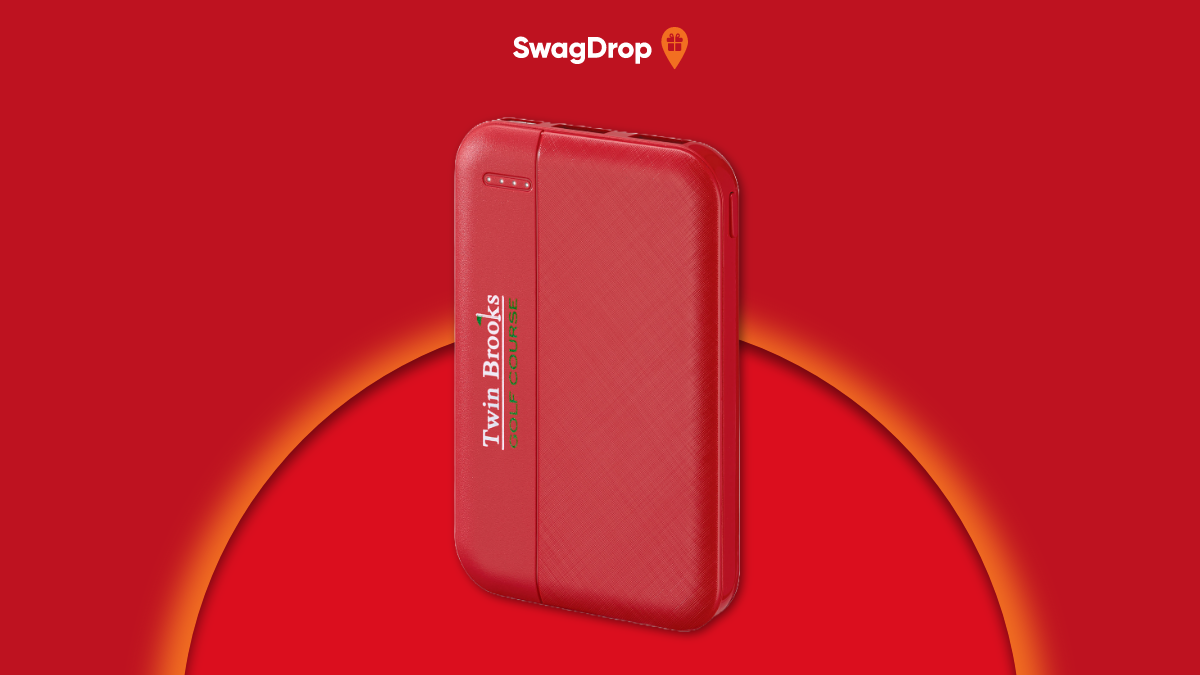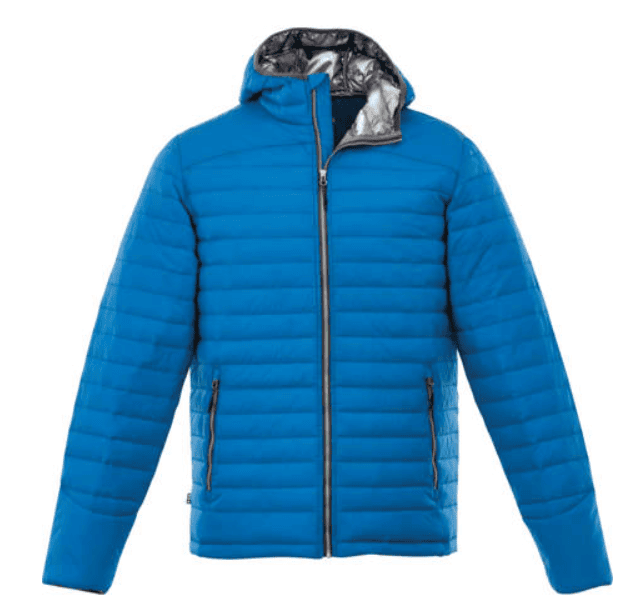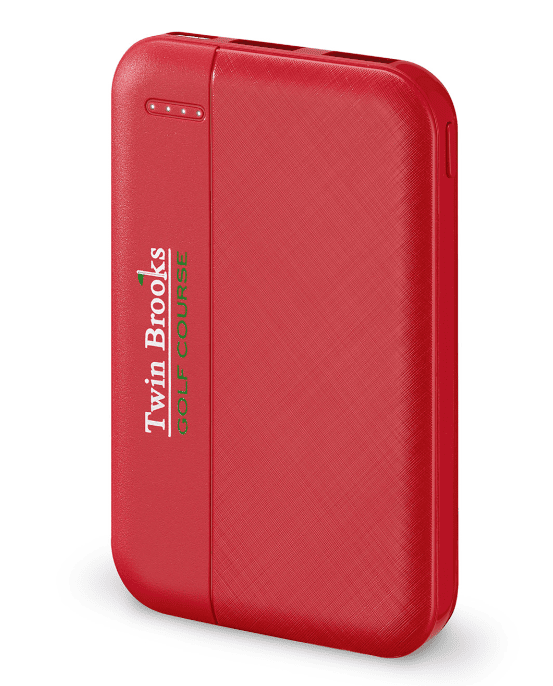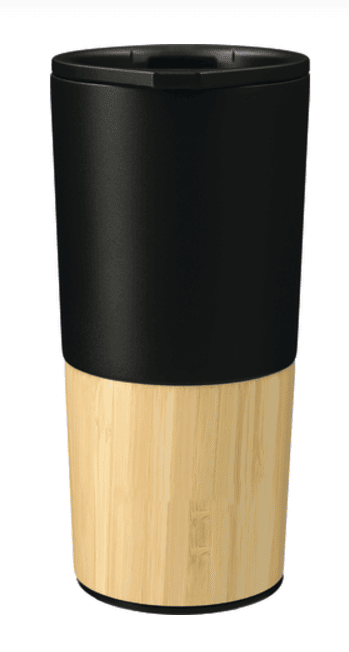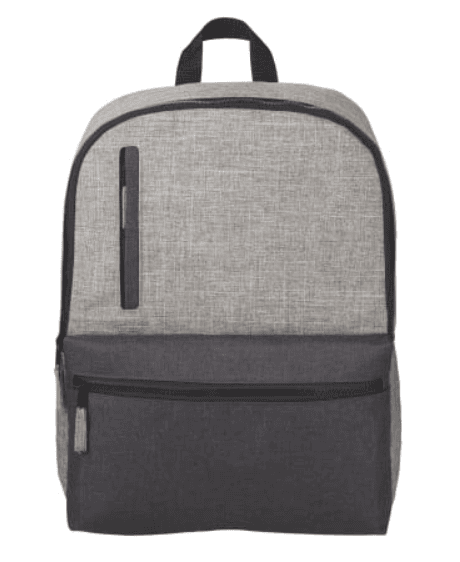You’ve got a budget, a brand to grow, and a team or an audience to impress.
But when it comes to swag, the main question that always comes up is whether it’s really worth it.
In 2025, swag means more than slapping your logo on a product; it’s a powerful tool for driving engagement, boosting morale, and creating lasting brand impressions.
This guide will walk you through what swag return on investment (ROI) is, how to track it, and what promotional products generate the best results.
We’ll also show you how to use our swag-on-demand stores to make the most out of every dollar.
Let’s get started!

Table of Contents
Why Is Swag ROI Hard to Calculate?
What Metrics Track Swag Effectiveness?
How Can Swag-On-Demand Stores Improve ROI?
What Kind of Swag Gets the Best ROI?
When Does Swag Deliver the Highest ROI?
Why Do Businesses Still Invest in Swag?
What Is Swag ROI?
Swag ROI is the measurable value your business gains from investing in creating and distributing promotional products. This metric reflects how well your swag supports goals like brand awareness, employee engagement, or lead generation.
You can measure the impact of your branded merchandise by tracking how many people saw or interacted with your swag, whether it sparked engagement or conversations, or how it influenced customer loyalty and conversions (we’ll dive deeper into those metrics soon!).
If your giveaways have a clear purpose and tie directly to a business goal, you’re much more likely to get results that make a real difference.
Now, let’s break down what a good return on swag investment really looks like.
What’s a Good ROI for Swag?
A solid return on your swag investment typically starts at a 2:1 ratio. In other words, for every dollar you spend, you’re aiming to make at least two back.
According to a BR Printers report, 75% of customers are more likely to buy from a company that gave them a promotional item, even over brands they already know.
Yet, besides boosting short-term sales, branded products also help build long-term brand awareness, improve lead quality, enhance customer and employee satisfaction, and make events more engaging.
Keep in mind, though, that “good” ROI can look different depending on your industry, audience, and goals. Therefore, you should set clear objectives upfront and track meaningful metrics, like cost per lead, engagement rates, and how often people actually redeem or use your swag.
Coming up next, we’ll explain why calculating swag ROI can be a bit tricky.
Why Is Swag ROI Hard to Calculate?
Swag ROI is hard to calculate because it blends both measurable outcomes and intangible benefits.
Directly linking a custom mug or T-shirt to a specific sale or lead often proves difficult because promotional products influence people in more subtle, long-term ways. You might see a boost in brand awareness or customer loyalty months after someone receives your gift, but tracking that journey from swag to sale is rarely straightforward.
Likewise, you typically use branded giveaways alongside other marketing strategies, making attribution even harder to pinpoint. For instance, you might hand out swag at an event, but follow-up emails, social media engagement, and word-of-mouth also play a key role in the final outcome.
However, you can streamline the process by tracking key performance indicators, as we’ll explain next.
What Metrics Track Swag Effectiveness?
To determine the effectiveness of your swag marketing strategy, you need to track the right metrics. These key performance indicators (KPIs) help you connect your investment to real outcomes.
Here are some of the most useful KPIs for promotional product marketing campaigns:
- Cost per acquisition (CPA) tells you how much it costs to gain a lead or customer through swag. Lower CPA means higher efficiency.
- Redemption rate shows the percentage of recipients who completed a desired action, like scheduling a demo or signing up after receiving a promotional gift.
- Brand impressions track how often people see your logo or message through promo items. Visibility matters, especially for top-of-funnel brand awareness.
- Repeat engagement monitors continued interactions from people who received company swag, signaling long-term interest and brand connection.
- Event-specific conversions reveal the actions triggered by your corporate event or trade show giveaways, such as sign-ups or purchases.
- Employee retention or internal NPS measures the impact of corporate gifts on team engagement and job satisfaction.
Now, let’s see how you can bring these metrics together to calculate your swag ROI.
How Do You Measure Swag ROI?
Measuring swag ROI requires a few smart tactics that connect your giveaways to real business outcomes.
Here are five practical ways to determine the return on investment of your campaigns.

Let’s explore how each method works.
1. Track engagement rates through QR codes or landing pages
Start by adding QR codes or short URLs to your promotional product tags, packaging, or custom notes.
When someone scans the code or visits the link, they land on a campaign-specific page, offer, or video. You can then track click-through rates, time on page, or sign-ups.
This approach helps you see how effective your swag is at sparking digital interest right away and gives you a clear trail of engagement data.
2. Connect swag to lead generation outcomes
Promotional materials can be a powerful tool for capturing leads if you tie them to a specific action.
For example, you can offer event swag that requires attendees to scan a QR code and fill out a form. Alternatively, you can ship a branded gift to prospects who book a meeting.
These actions let you attribute new leads (and their quality!) directly to your swag efforts, making it easier to justify the spend.
3. Survey employee or client satisfaction
After your corporate gift reaches the recipient, follow up with a quick survey to find out how it made them feel. Ask about the product’s quality, usefulness, and the impression it left.
When you use swag to show employee or client appreciation, this feedback helps you measure emotional response. A positive gifting experience often leads to increased loyalty, morale, and word-of-mouth referrals. Find inspiration in our complete guides to Employee Appreciation Gifts and Customer Appreciation Ideas.
4. Monitor client retention or repeat engagement
Keep an eye on long-term client behavior.
For instance, you can check if your welcome gift box for new clients leads to higher renewal rates or if customers who received promo items refer others or place more frequent orders.
Compare retention and engagement between gift recipients and a control group to see how strategic gift-giving can turn one-time buyers into loyal brand advocates over time.
5. Analyze cost vs. return
To truly understand how well your corporate gifting campaigns are performing, you need to look at how much you spent versus what you gained.
Add up design, production, shipping, and fulfillment, then compare those costs against the value of the leads or deals your campaign produced. CRM tools and campaign tagging simplify this process.
For instance, if you spent $3,000 on branded merchandise and that effort helped you close $12,000 in new sales, you’ve achieved a 4X return on your investment.
For more insights, check out our in-depth guide to measuring the success and ROI of corporate gifting.
Next up, find out how swag-on-demand stores can simplify gifting and boost your ROI.
How Can Swag-On-Demand Stores Improve ROI?
SwagDrop’s swag-on-demand stores help you get more value from every branded item you send.
Instead of wasting your budget on generic bulk orders that may never get used, you can offer personalized, high-quality gifts through a fully managed storefront. Explore additional tips in our detailed Swag Budget guide.
Here’s how our solution delivers results.
Easy setup and full-service management
You don’t need to build or manage the virtual swag stores yourself. We handle the setup, product uploads, and fulfillment.
You just tell us what you want, and we’ll get your gift store up and running in no time. The best part is that we can build you multiple virtual shops for each of your active campaigns.
Once the shop is live, your team or clients place their orders, and we take care of processing, production, and shipping.
Personalized gifting that actually gets used
Our online gift shops allow recipients to choose their favorite swag from a curated selection of high-quality items.
Your clients or employees can pick the right size, choose their preferred color, and even add their name to certain products.
This level of customization makes the gift feel personal and thoughtful. Therefore, the recipient will likely use or wear the product often and rave about it to their friends, generating brand exposure and positive associations.
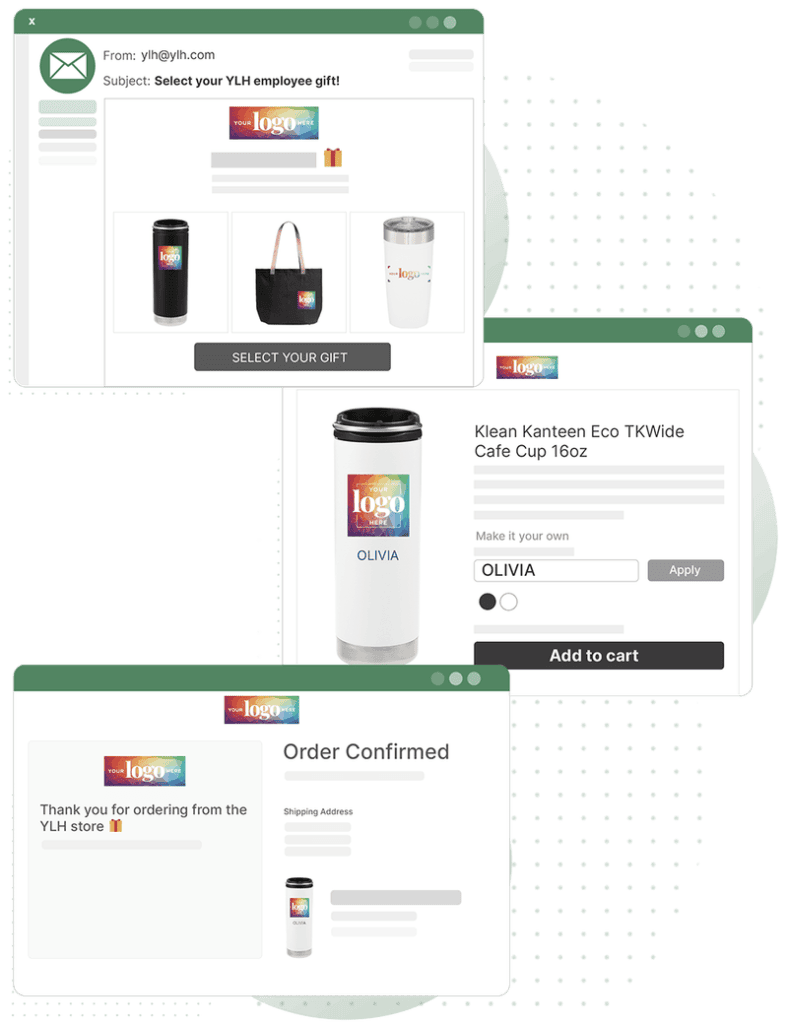
Zero inventory and zero headaches
Guessing quantities, managing warehouses, and worrying about leftover stock adds stress and risk to traditional swag programs.
Our on-demand model eliminates all these issues by producing swag and charging you for it only when someone places an order.
You no longer have to invest in inventory upfront, cover storage costs, or waste resources on unused merchandise.
Clear, predictable pricing
We strongly believe that budgeting for swag should be simple, which is why our pricing includes no setup fees and no inventory costs.
You pay only for what recipients order, and shipping across the U.S. is a flat $9.95 per order.

This straightforward model makes it easy to estimate spend and measure your ROI without surprises or hidden fees.
Now that you know how to maximize returns with smarter distribution, let’s look at the types of promotional products that deliver the highest ROI.
What Kind of Swag Gets the Best ROI?
Some swag works harder for your brand than others. The best promo items create long-lasting impressions, get regular use, and feel valuable to the person receiving them.
Here’s a side-by-side comparison of five top swag categories based on perceived value, best use case, and ROI potential.
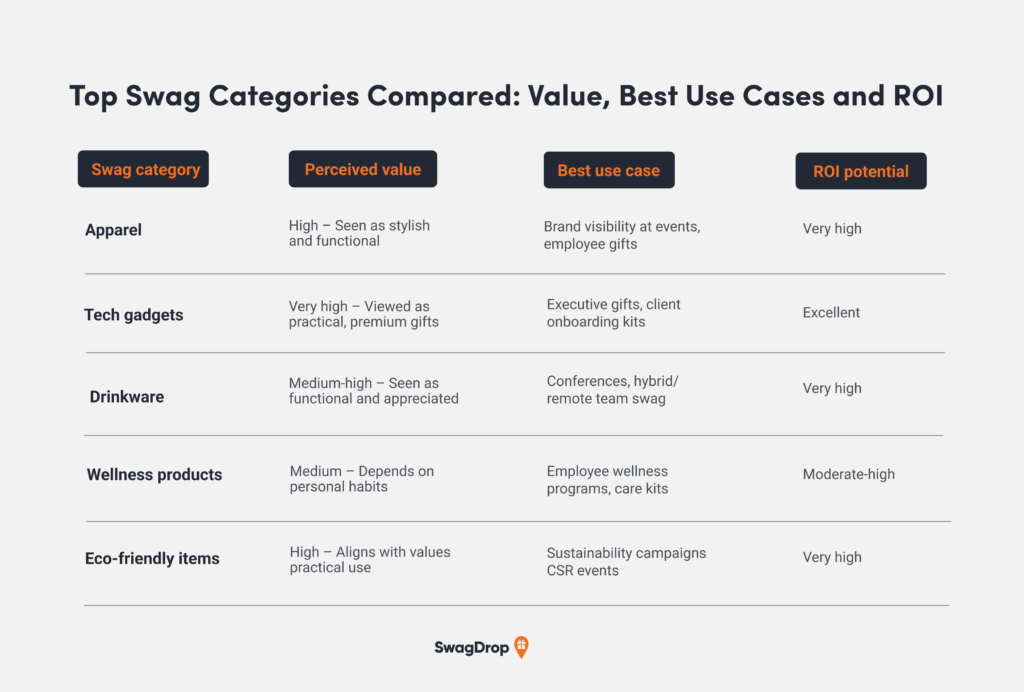
Let’s take them one by one and discover some exciting statistics from the 2023 Ad Impressions Study.
Apparel
Branded apparel, such as t-shirts, hoodies, and jackets, puts your logo front and center in everyday life.
Outerwear leads the way, generating over 7,800 lifetime impressions, far more than t-shirts, which average just over 5,000, according to the ASI report. This promo product category is also the most influential for both men and women, making it a smart bet.
The stylish Silverton branded jacket with a water-repellent finish and Echoheat lining is an excellent option.
Tech gadgets
People love practical tech swag, especially on the go, which is why power banks, wireless chargers, and earbuds are always a hit.
In fact, according to the Ad Impressions Study, 40% of Americans say receiving a power bank makes them more likely to do business with the brand that gave it to them.
Our clients can’t get enough of the compact iLive power bank, offering a 5,000 mAh battery capacity.
Drinkware
Custom tumblers, water bottles, and mugs land in kitchens, offices, and gyms everywhere, with people using them daily.
The Advertising Specialty Institute found that 63% of U.S. consumers keep and use promo drinkware for a year or more, generating steady impressions over time and repeated brand exposure.
Wow recipients with the exquisite Welly tumbler, which keeps drinks hot for 8 hours and cold for 24 hours.
Wellness products
Wellness gifts for employees and clients promote physical and mental health. Therefore, this category can include everything from hand sanitizers and massage guns to fitness trackers and yoga gift sets.
According to the ASI report, healthcare products rank second in influence among women after outerwear.
For instance, you can inspire gift recipients to exercise and unwind with our customizable Home Studio set.
Eco-friendly items
Eco-friendly promotional products, such as organic cotton totes, bamboo lunch boxes, and recycled paper notebooks, signal brand values and attract eco-conscious consumers.
In fact, the Advertising Specialty Institute found that 46% of U.S. consumers view a brand more favorably when it offers them an eco-friendly promo item.
Combine functionality with sustainability with a branded backpack made of 100% recycled PET.
Another key aspect to consider is choosing the right timing for handing out branded products to deliver the best return, which we’ll explore next.
When Does Swag Deliver the Highest ROI?
Swag delivers the highest ROI when it supports moments of connection, celebration, or change. On these occasions, people are most open to your message, and the right branded gift can leave a lasting impression.
Here are some of the best times to hand out promotional items.
Product launches
Generate excitement and strengthen brand recall by sending swag to early product adopters, influencers, or your staff. Giveaways turn a launch into a memorable experience.
Recruiting and onboarding
Welcoming candidates and new hires with thoughtful gifts impacts retention. After all, first impressions matter, and branded gear helps build a sense of pride and belonging from day one. Check out our Onboarding Best Practices guide for more insights.
Trade shows and conferences
Set yourself apart with trade show and conference swag that’s useful, memorable, and well-designed. These promotional materials help draw attention to your booth, spark conversations, and offer you a reason to follow up afterward.
Customer renewals or upsells
Celebrate contract anniversaries or upgrades with premium client gifts. This simple gesture shows appreciation, builds loyalty, and warms up the conversation before you ask for more.
Virtual events
Send virtual swag to participants ahead of your online event to boost engagement. Attendees will show up more invested, feel more connected, and remember your brand long after the event.
Milestone celebrations
Mark significant moments for your company, such as anniversaries, funding rounds, or mergers, with personalized gifts. This strategy reinforces shared success and strengthens emotional bonds across teams or clients.
You should also celebrate major milestones in your employees’ career path, like promotions, years of service, or project wins, with swag that shows recognition and builds long-term loyalty.
Finally, let’s explore some of the main reasons why businesses keep investing in promotional products, even in digital-first environments.
Why Do Businesses Still Invest in Swag?
Businesses continue to invest in swag because this marketing strategy gets results.
According to PPAI, the promotional products industry registered a record $26.78 billion in 2024.
Check out some of the main reasons why swag is still a powerful marketing tool, backed up by statistics.
- Strong brand recall. The PPAI’s 2023 Consumer Study revealed that 66% of consumers can recall the name of the brand on a logoed product they’ve received in the past 12 months.
- High usage rate. According to a Vistaprint survey, in 2025, 83% of consumers actively use the branded items they receive, up from just 54% the year before.
- Positive brand perception. 58% of U.S. consumers said receiving a promotional item positively changed how they see a brand, as determined by the same Vistaprint survey.
- Higher employee retention. A 2024 survey by Quality Logo Products found that employees who receive branded gifts stay with their companies 1.5 years longer, on average, than those who don’t.
- Increased job satisfaction. Quality Logo Products also discovered that receiving company swag makes 60% of employees feel more valued and connected to their company.
Now, let’s wrap things up.
Tips, tricks, and inspiration delivered straight to your inbox.
Over to You!
In 2025, swag is smarter, more strategic, and packed with ROI potential.
Align your promotional products with key moments, track the right metrics, and let people choose what they actually want, allowing your giveaways to deliver real value, internally and externally.
Browse our SwagDrop shop today and gain access to one-of-a-kind swag your team and customers will love.

